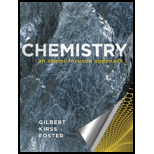
Chemistry: An Atoms-Focused Approach
14th Edition
ISBN: 9780393912340
Author: Thomas R. Gilbert, Rein V. Kirss, Natalie Foster
Publisher: W. W. Norton & Company
expand_more
expand_more
format_list_bulleted
Question
Chapter 11, Problem 11.39QA
Interpretation Introduction
To calculate
The molality of glucose, acetic acid, and baking soda from given mole and mass of solvent
Expert Solution & Answer
Want to see the full answer?
Check out a sample textbook solution
Students have asked these similar questions
Which of these compounds is Ester formed from the reaction of acetic acid and one propanol 
Describe the four labeled parts of the reaction diagram from the reaction of sucrose, breaking down with and without an enzyme.
How to determine the product with mechanism showed
Chapter 11 Solutions
Chemistry: An Atoms-Focused Approach
Ch. 11 - Prob. 11.1VPCh. 11 - Prob. 11.2VPCh. 11 - Prob. 11.3VPCh. 11 - Prob. 11.4VPCh. 11 - Prob. 11.6VPCh. 11 - Prob. 11.7VPCh. 11 - Prob. 11.8VPCh. 11 - Prob. 11.9VPCh. 11 - Prob. 11.10VPCh. 11 - Prob. 11.11QA
Ch. 11 - Prob. 11.12QACh. 11 - Prob. 11.13QACh. 11 - Prob. 11.14QACh. 11 - Prob. 11.15QACh. 11 - Prob. 11.16QACh. 11 - Prob. 11.17QACh. 11 - Prob. 11.18QACh. 11 - Prob. 11.19QACh. 11 - Prob. 11.20QACh. 11 - Prob. 11.21QACh. 11 - Prob. 11.22QACh. 11 - Prob. 11.23QACh. 11 - Prob. 11.24QACh. 11 - Prob. 11.25QACh. 11 - Prob. 11.26QACh. 11 - Prob. 11.27QACh. 11 - Prob. 11.28QACh. 11 - Prob. 11.29QACh. 11 - Prob. 11.30QACh. 11 - Prob. 11.31QACh. 11 - Prob. 11.32QACh. 11 - Prob. 11.33QACh. 11 - Prob. 11.34QACh. 11 - Prob. 11.35QACh. 11 - Prob. 11.36QACh. 11 - Prob. 11.37QACh. 11 - Prob. 11.38QACh. 11 - Prob. 11.39QACh. 11 - Prob. 11.40QACh. 11 - Prob. 11.41QACh. 11 - Prob. 11.42QACh. 11 - Prob. 11.43QACh. 11 - Prob. 11.44QACh. 11 - Prob. 11.45QACh. 11 - Prob. 11.46QACh. 11 - Prob. 11.47QACh. 11 - Prob. 11.48QACh. 11 - Prob. 11.49QACh. 11 - Prob. 11.50QACh. 11 - Prob. 11.51QACh. 11 - Prob. 11.52QACh. 11 - Prob. 11.53QACh. 11 - Prob. 11.54QACh. 11 - Prob. 11.55QACh. 11 - Prob. 11.56QACh. 11 - Prob. 11.57QACh. 11 - Prob. 11.58QACh. 11 - Prob. 11.59QACh. 11 - Prob. 11.60QACh. 11 - Prob. 11.61QACh. 11 - Prob. 11.62QACh. 11 - Prob. 11.63QACh. 11 - Prob. 11.64QACh. 11 - Prob. 11.65QACh. 11 - Prob. 11.66QACh. 11 - Prob. 11.67QACh. 11 - Prob. 11.68QACh. 11 - Prob. 11.69QACh. 11 - Prob. 11.70QACh. 11 - Prob. 11.71QACh. 11 - Prob. 11.72QACh. 11 - Prob. 11.73QACh. 11 - Prob. 11.74QACh. 11 - Prob. 11.75QACh. 11 - Prob. 11.76QACh. 11 - Prob. 11.77QACh. 11 - Prob. 11.78QACh. 11 - Prob. 11.79QACh. 11 - Prob. 11.80QACh. 11 - Prob. 11.81QACh. 11 - Prob. 11.82QACh. 11 - Prob. 11.83QACh. 11 - Prob. 11.84QA
Knowledge Booster
Similar questions
arrow_back_ios
SEE MORE QUESTIONS
arrow_forward_ios
Recommended textbooks for you
 ChemistryChemistryISBN:9781305957404Author:Steven S. Zumdahl, Susan A. Zumdahl, Donald J. DeCostePublisher:Cengage Learning
ChemistryChemistryISBN:9781305957404Author:Steven S. Zumdahl, Susan A. Zumdahl, Donald J. DeCostePublisher:Cengage Learning ChemistryChemistryISBN:9781259911156Author:Raymond Chang Dr., Jason Overby ProfessorPublisher:McGraw-Hill Education
ChemistryChemistryISBN:9781259911156Author:Raymond Chang Dr., Jason Overby ProfessorPublisher:McGraw-Hill Education Principles of Instrumental AnalysisChemistryISBN:9781305577213Author:Douglas A. Skoog, F. James Holler, Stanley R. CrouchPublisher:Cengage Learning
Principles of Instrumental AnalysisChemistryISBN:9781305577213Author:Douglas A. Skoog, F. James Holler, Stanley R. CrouchPublisher:Cengage Learning Organic ChemistryChemistryISBN:9780078021558Author:Janice Gorzynski Smith Dr.Publisher:McGraw-Hill Education
Organic ChemistryChemistryISBN:9780078021558Author:Janice Gorzynski Smith Dr.Publisher:McGraw-Hill Education Chemistry: Principles and ReactionsChemistryISBN:9781305079373Author:William L. Masterton, Cecile N. HurleyPublisher:Cengage Learning
Chemistry: Principles and ReactionsChemistryISBN:9781305079373Author:William L. Masterton, Cecile N. HurleyPublisher:Cengage Learning Elementary Principles of Chemical Processes, Bind...ChemistryISBN:9781118431221Author:Richard M. Felder, Ronald W. Rousseau, Lisa G. BullardPublisher:WILEY
Elementary Principles of Chemical Processes, Bind...ChemistryISBN:9781118431221Author:Richard M. Felder, Ronald W. Rousseau, Lisa G. BullardPublisher:WILEY

Chemistry
Chemistry
ISBN:9781305957404
Author:Steven S. Zumdahl, Susan A. Zumdahl, Donald J. DeCoste
Publisher:Cengage Learning

Chemistry
Chemistry
ISBN:9781259911156
Author:Raymond Chang Dr., Jason Overby Professor
Publisher:McGraw-Hill Education

Principles of Instrumental Analysis
Chemistry
ISBN:9781305577213
Author:Douglas A. Skoog, F. James Holler, Stanley R. Crouch
Publisher:Cengage Learning

Organic Chemistry
Chemistry
ISBN:9780078021558
Author:Janice Gorzynski Smith Dr.
Publisher:McGraw-Hill Education

Chemistry: Principles and Reactions
Chemistry
ISBN:9781305079373
Author:William L. Masterton, Cecile N. Hurley
Publisher:Cengage Learning

Elementary Principles of Chemical Processes, Bind...
Chemistry
ISBN:9781118431221
Author:Richard M. Felder, Ronald W. Rousseau, Lisa G. Bullard
Publisher:WILEY